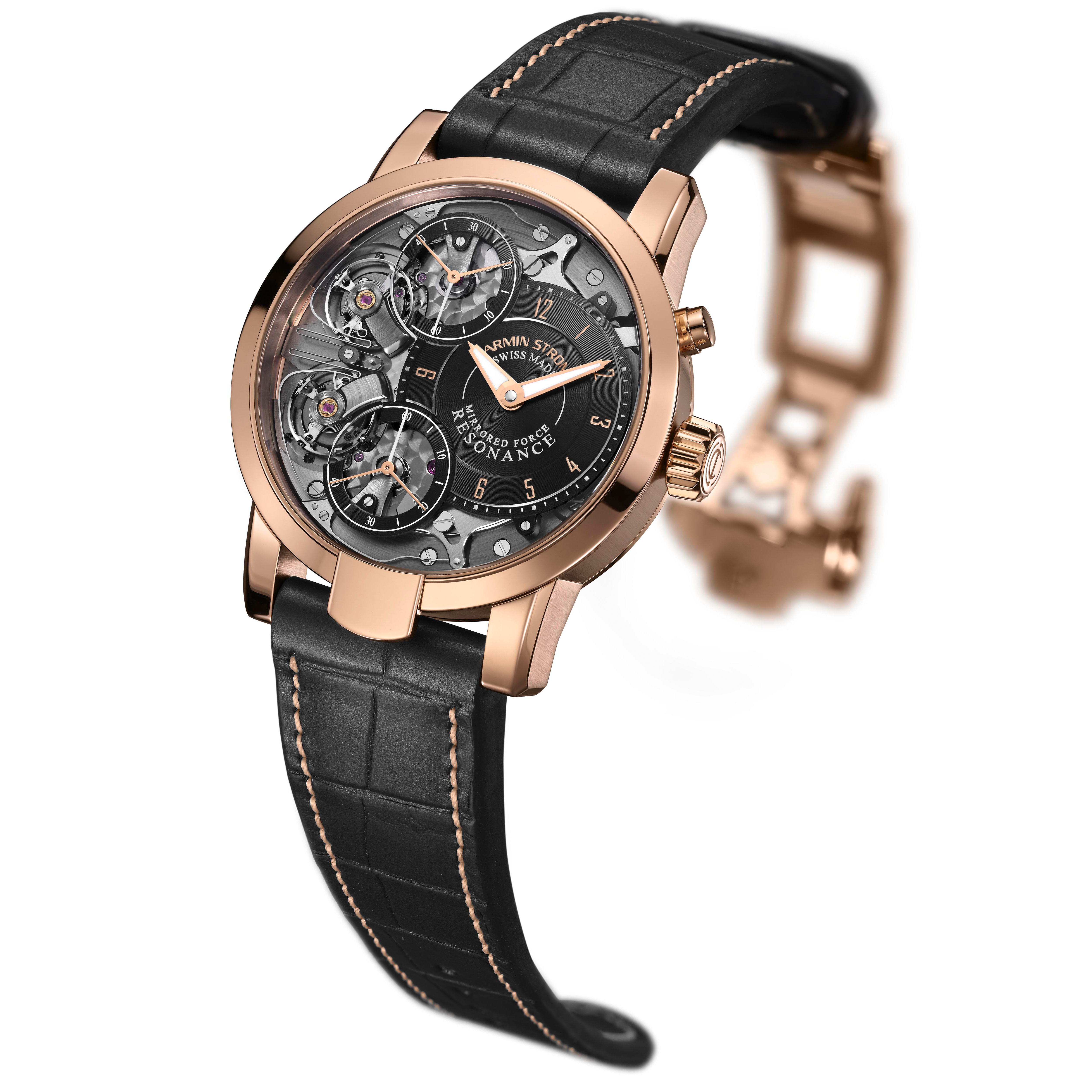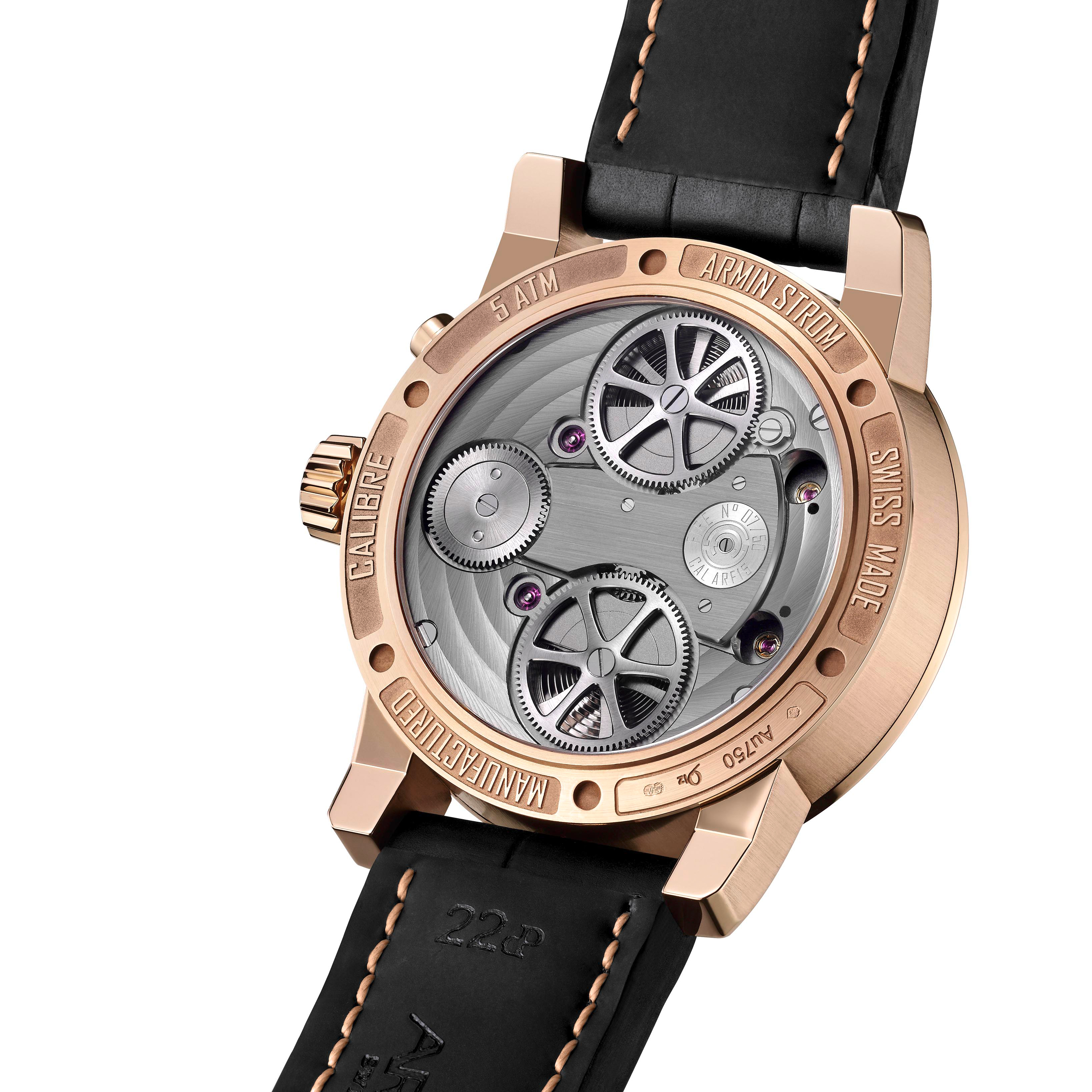
Mirrored Force Resonance
Power reserve: 48 h, 25'200 vph
Mirrored Force Resonance: ARMIN STROM Propels Resonance Firmly into the 21st Century with Watchmaking Breakthrough
Two oscillating bodies in close proximity influence each other and eventually synchronize; this is a phenomenon of physics known as resonance. ARMIN STROM introduces the Mirrored Force Resonance, a resonating dual regulator developed for maximum precision with its whole captivating mechanism on full display dial side.
The Concept of Resonance
Resonance is a sophisticated and demanding horological technique that has rarely been attempted, let alone mastered. In the pursuit of horological accuracy, precision, and rate stability resonance has generally involved utilizing two independent mainsprings, gear trains, escapements, and balances, each connected by a rack and pinion to allow fine tuning of the distance between them. Precise adjustment of the distance between the two regulators is necessary to incite resonance, which sees the two balances finding a concurrent rhythm in opposite directions so as to continuously average out errors for maximum accuracy.
One body in motion relays its vibrations to its surroundings. When another body with a similar natural resonant frequency to the first receives these vibrations, it will absorb energy from the first and start vibrating at the same frequency in a sympathetic manner. The first body acts as the “exciter,” while the second acts as the “resonator.”
The phenomenon of synchronized motion in horology has fascinated watchmakers since the time of Christiaan Huygens (1629-1695). Huygens, inventor of the pendulum clock, was the first to discover the resonance of two separate pendulum clocks, which he logically surmised should keep slightly different time. When hung from a common beam, however, the pendulums of the adjacent clocks synchronized; subsequent researchers confirmed that the common wooden beam coupled the vibrations and created resonance. The two pendulums functioned as one in a synchronous manner. In the eighteenth century, Abraham-Louis Breguet demonstrated his mastery of the phenomenon with his double pendulum resonance clock.
The advantages of resonance are threefold:
1. A stabilizing effect on timekeeping (advantageous to accuracy).
2. A conservation of energy (think of a professional cyclist riding in the shadow of another cyclist in a racing situation).
3. A reduction of negative effects on timekeeping accuracy due to outside perturbation such as shock to the balance staff, which in turn keeps the rate more stable and increases precision.
An outside shock that slows one of the balances down increases the speed of the other one by the same amount; both balances will strive to get back in resonance, thereby averaging and minimizing the effects of the outside influence as they find their rhythm.
To provide an idea of how difficult the horological execution of this concept is, an exhaustive list of watchmakers that have successfully used resonance in an extremely limited number of timepieces includes Antide Janvier (1751-1855), Abraham-Louis Breguet (1747-1823), so few modern clock- and watchmakers that they can likely be counted on one hand.
Manufacturing
Unlike the majority of watch companies operating today, ARMIN STROM is a full-fledged manufacture with in-house manufacturing capability. The resonant Caliber ARF15 is a classically constructed manually wound movement that was conceived, manufactured, assembled, and regulated in-house. It beats at a 3.5 Hertz (25,200 vph) frequency, allowing the observer to really appreciate the patented, resonant regulators in action. The movement is resolutely modern, with a novel, yet impeccably executed finish providing a roomy and stable stage for the real show: the symmetrical twin display of seconds, which are bound by a single spring.
The resonance clutch spring needed to realize the Mirrored Force Resonance’s twin display of seconds was so technical that the brand’s team, under the direction of technical director Claude Greisler, was left with no choice other than to create what it needed in house. Like Calibre ARF15, the resonance clutch spring comprises only a traditional horological material: steel. Greisler and his team spent fully two and a half years perfecting the shape and characteristics of the spring: calculating, optimizing, simulating, testing, and improving again and again until the spring had the optimal, unique form needed to connect ARMIN STROM’s two sets of oscillators, each comprising twin balance wheels and balance springs.
Since the two connected oscillators make their revolutions in opposite directions, which is eminently visible on the dial side of the watch, one rotating clockwise and the other counterclockwise, the animated elements look much like they are performing a magic trick. If the 48-hour power reserve has been exhausted and the movement requires a fresh injection of energy through winding, the twin balance wheels need approximately 10 minutes to become synchronous. In case of any outside influence in the form of shock, it takes only a few minutes for the two balances to find their resonant rhythm once again.
This is because it is not the balance wheels that Armin Strom’s technical team has connected using the resonance clutch spring, but rather the balance spring studs, which receive the impulses.
The case band pusher at 2 o’clock resets the luminous twin seconds’ displays to zero, simultaneously resetting the twin balance wheels. The Mirrored Force Resonance is the most complicated timepiece that Armin Strom manufactures; it is not surprising that a patent has been registered on it.
Background
Claude Greisler’s idea behind the Mirrored Force Resonance was to create an innovative way of improving an old concept, one that is horology’s very reason for being: precision and accuracy. ARMIN STROM’s Mirrored Force Resonance is a new, better, and more interesting way of executing and displaying an old idea.
The raison d’être of the Mirrored Force Resonance is to display the interesting functionality of the resonant balances while improving the watch’s overall precision. The resonance clutch spring provides the watch with a fascinating and patented “animation” of the way it functions. This remains in line with the philosophy of ARMIN STROM as a brand: no nonsense, just good, proprietary mechanics presented in an impeccably finished and interesting way. The resonance clutch spring is exciting in another way, too: it visually proves this timepiece’s resonance.



